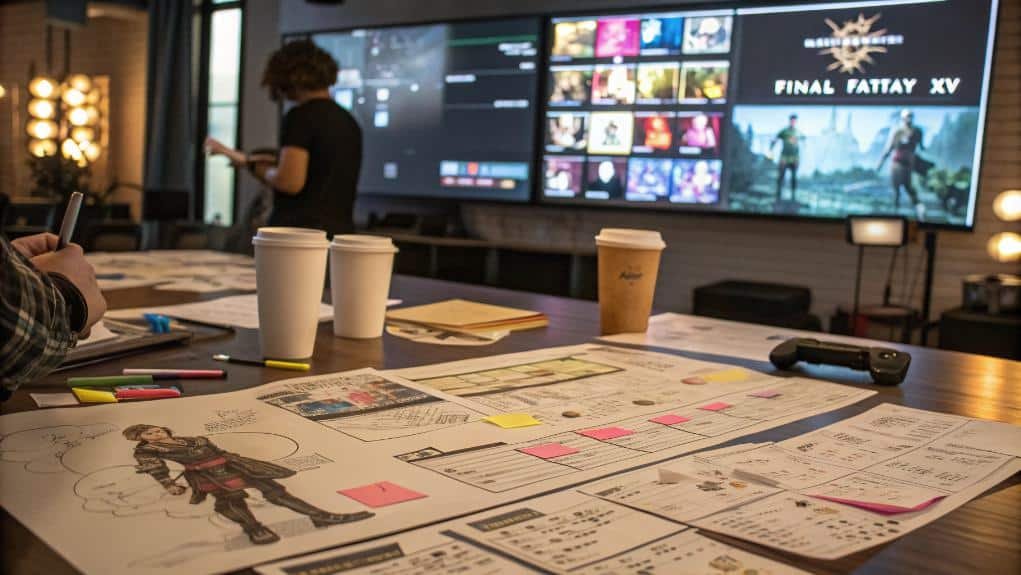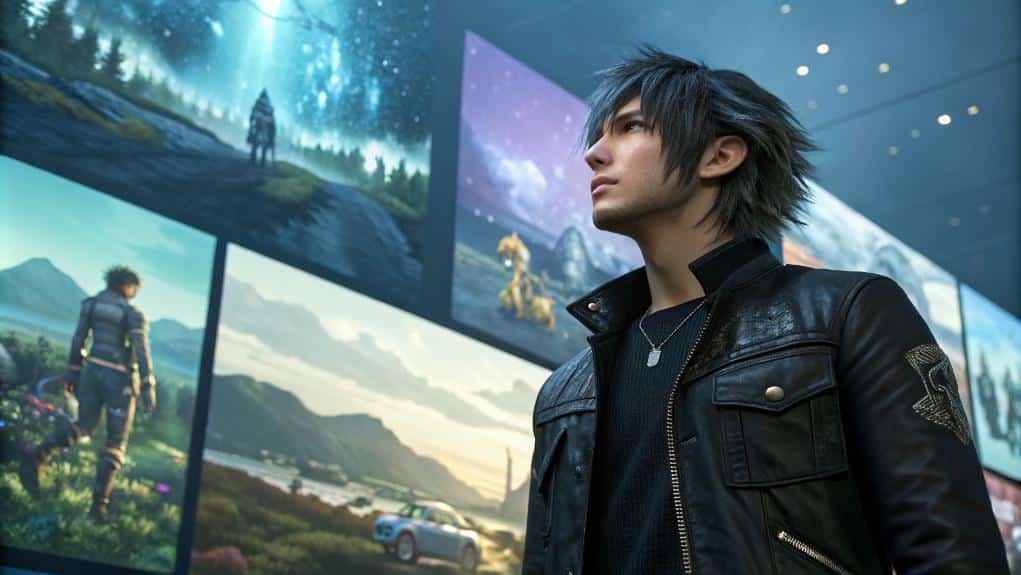Final Fantasy XV's history spans a decade, beginning as Final Fantasy Versus XIII in 2006 under Tetsuya Nomura. Development faced numerous setbacks, leading to the rebranding in 2012 with Hajime Tabata at the helm. The game features the magical world of Eos, fraught with political intrigue and the journey of Noctis, who evolves from a reluctant prince to a True King. The title's mixed reception prompted discussions on narrative depth, while expansions and DLC enriched the experience. This tumultuous journey not only shaped its gameplay mechanics but also laid the groundwork for future projects within the franchise. There's much more to uncover.
Key Takeaways
- Final Fantasy XV began as Final Fantasy Versus XIII in 2006, led by Tetsuya Nomura, but faced significant development delays.
- The project was rebranded to Final Fantasy XV in 2012, with Hajime Tabata taking over as director, leading to a more focused approach.
- Development spanned approximately ten years, marked by engine limitations, resource allocation issues, and a shift to the Luminous Engine.
- The game is set in the world of Eos, featuring four nations and complex political dynamics, with themes of loyalty and sacrifice among characters.
- Multimedia expansions, including character episodes and multiplayer content, enriched the narrative and addressed player feedback, solidifying the game's legacy.
Game Development Timeline

The development timeline of Final Fantasy XV reveals a complex journey marked by changes in vision and management. Initially conceived as Final Fantasy Versus XIII in 2006, Tetsuya Nomura led the project, focusing on intricate character designs and a compelling narrative.
However, the project faced delays, partly due to its connection with Final Fantasy XIII and a miscommunication about its status. By 2012, the game's rebranding to Final Fantasy XV coincided with a shift to eighth-generation platforms, bringing Hajime Tabata on board as the new director. This transition occurred after the project had already experienced a lengthy development period that lasted about ten years.
Under Tabata's leadership, the development team made significant changes to the game's story and game mechanics, aiming for a more immersive experience. The visual design evolved considerably, showcasing an expansive open world filled with dynamic environments and lifelike characters.
Feedback from early demos, like Episode Duscae, played an essential role in refining gameplay elements, ensuring the mechanics aligned with the new vision. The three-year development cycle culminated in the game's worldwide release in November 2016, marking a decade-long journey filled with challenges and innovations that ultimately reshaped the Final Fantasy franchise.
The World of Eos
The World of Eos
Set against the backdrop of a rich narrative, the world of Eos is intricately designed, featuring a diverse geography and complex political landscape.
Eos Geography comprises four distinct nations: Lucis, Accordo, Tenebrae, and Niflheim. Lucis, the heartland, houses the magical Crystal, essential for its protection and power. Accordo thrives as a union of free trading cities, while Tenebrae, ruled by the Oracle, stands as a spiritual bastion communicating with the divine. Niflheim, a technologically advanced empire, seeks dominance over Eos, echoing the ambitions of the fallen Solheim. The world of Eos is also enhanced by a post-release update that allows players to control all four characters during battles, adding depth to the gameplay experience.
The Astrals, six divine beings, influence Eos profoundly, serving as guardians against darkness. Their presence is vital, especially as the Starscourge, a devastating plague consuming natural light, threatens the domain. This calamity transforms the afflicted into Daemons, underscoring the urgency of the True King's prophesied appearance.
The ongoing war between Lucis and Niflheim, coupled with the weakening health of Lucis's king, reveals the intricate politics at play. As Niflheim gains territory, the Crystal's draining power symbolizes both hope and despair in the fight against the encroaching darkness, marking the delicate balance of Eos's fate.
Key Characters and Factions

In the intricate narrative of Final Fantasy XV, Noctis Lucis Caelum stands as the reluctant hero, burdened by destiny and his connection to Lunafreya, the Oracle whose powers play a vital role in the unfolding events. The ambitions of Niflheim, led by the cunning Ardyn Izunia, introduce a formidable conflict that tests the bonds of friendship and loyalty among the key characters. As the struggle between light and darkness intensifies, the interplay of these factions shapes the fate of Eos and its inhabitants. The character development of Gladiolus Amicitia, who serves as Noctis's protector, highlights the importance of friendship and loyalty throughout the story.
Noctis Lucis Caelum
Noctis Lucis Caelum, the central figure of Final Fantasy XV, embodies the complexities of royal duty and personal sacrifice. As the heir to the Lucian throne, Noctis grapples with the weight of his responsibilities while maneuvering his relationships with friends and foes alike. His motivations stem from a desire to reclaim the Crystal and save his kingdom from darkness, all while confronting the burdens of his lineage. He was chosen by the Crystal at a young age, which further emphasizes his role as the True King.
- Royal Heritage: Heir to the Lucian throne, Noctis struggles with expectations versus personal desires.
- Companionship: His bond with Gladiolus, Ignis, and Prompto emphasizes loyalty and friendship throughout his journey.
- Sacrifice: Ultimately, Noctis's quest leads him to a tragic yet noble sacrifice to fulfill his destiny as the True King.
Noctis's relationships shape his character development; his connections highlight the duality of his nature—benevolent yet selfish.
His interactions with Lunafreya and the Astrals further illuminate his internal conflicts, driving him toward the prophesied fate that awaits him.
Through trials and tribulations, Noctis emerges as a profound symbol of sacrifice and the struggle to balance duty with personal desires.
Lunafreya and the Oracles
Lunafreya Nox Fleuret, as the Oracle, stands at the intersection of duty and destiny within the world of Final Fantasy XV. Created during a significant story rewrite, she replaces the initial character Stella Nox Fleuret and becomes an indispensable figure in Eos, responsible for communicating with the Astrals. Engaged to Noctis Lucis Caelum, her role isn't merely political; it embodies the weight of Oracle responsibilities, as she must guide Noctis in becoming the True King.
Lunafreya's relationship with her brother Ravus showcases the tension between familial loyalty and personal conviction. While Ravus attempts to restrict her, fearing the Empire's manipulation, Lunafreya's strength and dedication shine through. She actively aids Noctis, forming crucial covenants with the Astrals, often at great personal cost. Her character was designed to project strength and grace, reinforcing her role as a powerful female figure in the narrative.
Lunafreya's sacrifices culminate in her final act, where she bequeaths the Ring of the Lucii to Noctis, ensuring his triumph against darkness. Her commitment to her role and the sacrifices she makes are essential to Noctis's journey, ultimately shaping the narrative of Final Fantasy XV and highlighting the profound impact of the Oracles in the battle for Eos.
Niflheim's Ambition and Ardyn
Niflheim's relentless pursuit of dominance over Eos serves as a backdrop for the empire's ambitious plans, primarily focused on seizing the magical Crystal that lies at the heart of Lucis.
Niflheim's tactics reveal a calculated approach, combining military might with cunning manipulation, particularly under the influence of Ardyn Izunia, the Imperial Chancellor. While the empire aims to eliminate the Lucis royal line, Ardyn's motivations run deeper, rooted in personal vendetta and a desire for revenge against his own bloodline.
Key elements of Niflheim's strategy include:
- Magitek Technology: The introduction of advanced machinery gives Niflheim an edge in warfare.
- Invasion of Insomnia: This bold move marks a significant step in their conquest, leading to the theft of the Crystal.
- Manipulation of Daemons: Niflheim experiments with militarizing these creatures to bolster their forces.
Despite their initial successes, Niflheim's ambitions ultimately crumble. The spread of the Starscourge decimates its leadership and leads to Ardyn's downfall, intertwining his fate with Noctis's in a tragic resolution for Eos. Ardyn's actions throughout the conflict highlight his role as an unusual antagonist, as he assists Noctis while pursuing his own revenge against the Lucian royal line.
Significant In-Game Events
In the tumultuous world of Final Fantasy XV, significant in-game events shape the destinies of its characters and the domain of Eos itself. The surprise attack on Insomnia by Niflheim sets the stage for Noctis's quest to reclaim the stolen Crystal. This theft catalyzes his transformation from a reluctant prince into the "True King," tasked with wielding the Crystal's powers to save Eos.
Throughout his journey, Noctis encounters significant battles, including his confrontations with Ravus and the mercenary Aranea, each pushing him toward greater character growth. Traveling with his companions Gladiolus, Ignis, and Prompto, Noctis navigates the vast landscapes of Lucis, utilizing the Regalia and chocobos. Notably, the return of the Final Fantasy XV crossover event allows players to relive key moments from the game while earning unique rewards.
The awakening of the Astral Leviathan, aided by Lunafreya, marks another pivotal moment, showcasing Noctis's evolving powers. However, tragedy strikes with Lunafreya's death, leaving Noctis in grief and igniting tensions within his group. Ignis's subsequent blindness during battle further complicates their dynamic, illustrating how these significant events deepen character relationships and drive the narrative forward.
Ultimately, these events intertwine fate and struggle, crafting a rich tapestry of growth amidst chaos.
Multimedia Expansions

As players explore deeper into the world of Final Fantasy XV, they encounter a rich array of multimedia expansions that enhance the core narrative and provide additional context to character arcs.
These expansions not only deepen the player's understanding of the main story but also introduce new gameplay experiences and collaborative events.
- Episode Series: The Season Pass includes episodes focusing on Gladiolus, Ignis, and Prompto, allowing players to experience their journeys during pivotal moments absent from the main storyline. This Season Pass includes exclusive content like the Holiday Pack + and Booster Pack +, enhancing the overall gameplay experience.
- Multiplayer Expansion—Comrades: This mode lets up to four players create custom avatars and engage in co-op missions, expanding the game's combat mechanics while filling in narrative gaps.
- Crossover Events: Collaborations with titles like Final Fantasy XIV and Terra Wars further enrich the universe, offering fans unique content that crosses boundaries between games.
These multimedia collaborations and crossover events illustrate the developers' commitment to expanding the Final Fantasy XV narrative, ensuring that players remain engaged long after the initial release.
The thoughtful integration of additional story elements solidifies the game's legacy within the franchise.
Development Challenges Faced
The development of Final Fantasy XV was marred by numerous challenges that considerably impacted its trajectory. Initially, the project faced significant engine limitations, as the Crystal Tools engine, designed for Final Fantasy XIII, proved inadequate for the expansive open-world concept envisioned for Versus XIII. This limitation, compounded by resource allocation issues within the development team, led to delays and a halt in progress.
As the project's ambition grew, so did its scope, ultimately becoming overly ambitious and unmanageable. When Hajime Tabata took over as director in 2012, he initiated a major shift in direction. This included rebranding Versus XIII to Final Fantasy XV and reevaluating content, which involved cutting certain features and characters to align with a more feasible project scope. The shift to the Luminous Engine addressed some technical issues but introduced new complexities, leading to a lengthy ten-year development cycle. Throughout this process, the development team experienced staff fatigue and accumulated technical debt, which further complicated their efforts.
The need for timely release ultimately limited the game's refinement, leaving a legacy of lessons learned about project management and scope for future endeavors. Additionally, the team's struggles with limited story development prior to 2013 rebranding highlighted the importance of a cohesive vision in game design.
DLC and Additional Content

Following the tumultuous development phase, Final Fantasy XV expanded its universe through a structured array of downloadable content (DLC) and additional content, which aimed to enhance the player experience and address narrative gaps. The DLC impact proved significant, allowing players to explore deeper into character-driven episodes that enriched the main storyline.
- Character Episodes: The first wave, featuring Gladiolus, Prompto, and Ignis, filled narrative gaps and provided a deeper understanding of each character, leading to the successful launch of Episode Ignis, which was well-received by fans.
- Gameplay Enhancements: The Royal Edition introduced free-roam sea traversal and the "Armiger Released" ability, elevating gameplay experiences.
- Time-Limited Events: Events like the Moogle Chocobo Carnival offered unique gameplay opportunities while promoting crossover content with titles like Final Fantasy XIV.
Each DLC pack, including the final Episode Ardyn, added additional story elements without fundamentally altering the main narrative.
Despite the DLC's separation from the core storyline, it effectively addressed player criticisms regarding missing details. Together, these expansions not only supplemented the game but also transformed it into a richer, more immersive experience, demonstrating the developers' commitment to delivering a thorough Final Fantasy XV universe.
Legacy and Impact
Final Fantasy XV stands out as a pivotal entry in the long-running series, leaving a complex legacy shaped by both its ambitious design and the mixed reception it garnered upon release. Although it faced criticism regarding its narrative structure and character development, it successfully blended traditional JRPG elements with modern open-world gameplay mechanics, influencing the direction of future titles in the franchise.
The game's devoted fan community appreciates its unique contributions, particularly in endgame content that offers extensive challenges. Furthermore, the cultural impact of Final Fantasy XV is evident in its art design, which merges magic and realism, solidifying its distinct visual identity.
| Legacy Aspect | Impact on Series |
|---|---|
| Ambitious Open World | Redefined gameplay mechanics |
| Mixed Reception | Reevaluation of narrative depth |
| Endgame Content | Influenced RPG design and engagement |
| Fan Community Engagement | Fostered nostalgia and broader appeal |

